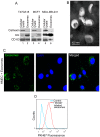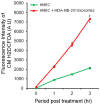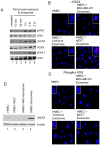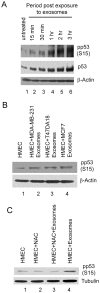Interactions between exosomes from breast cancer cells and primary mammary epithelial cells leads to generation of reactive oxygen species which induce DNA damage response, stabilization of p53 and autophagy in epithelial cells
- PMID: 24831807
- PMCID: PMC4022578
- DOI: 10.1371/journal.pone.0097580
Interactions between exosomes from breast cancer cells and primary mammary epithelial cells leads to generation of reactive oxygen species which induce DNA damage response, stabilization of p53 and autophagy in epithelial cells
Abstract
Exosomes are nanovesicles originating from multivesicular bodies and are released by all cell types. They contain proteins, lipids, microRNAs, mRNAs and DNA fragments, which act as mediators of intercellular communications by inducing phenotypic changes in recipient cells. Tumor-derived exosomes have been shown to play critical roles in different stages of tumor development and metastasis of almost all types of cancer. One of the ways by which exosomes affect tumorigenesis is to manipulate the tumor microenvironments to create tumor permissive "niches". Whether breast cancer cell secreted exosomes manipulate epithelial cells of the mammary duct to facilitate tumor development is not known. To address whether and how breast cancer cell secreted exosomes manipulate ductal epithelial cells we studied the interactions between exosomes isolated from conditioned media of 3 different breast cancer cell lines (MDA-MB-231, T47DA18 and MCF7), representing three different types of breast carcinomas, and normal human primary mammary epithelial cells (HMECs). Our studies show that exosomes released by breast cancer cell lines are taken up by HMECs, resulting in the induction of reactive oxygen species (ROS) and autophagy. Inhibition of ROS by N-acetyl-L-cysteine (NAC) led to abrogation of autophagy. HMEC-exosome interactions also induced the phosphorylation of ATM, H2AX and Chk1 indicating the induction of DNA damage repair (DDR) responses. Under these conditions, phosphorylation of p53 at serine 15 was also observed. Both DDR responses and phosphorylation of p53 induced by HMEC-exosome interactions were also inhibited by NAC. Furthermore, exosome induced autophagic HMECs were found to release breast cancer cell growth promoting factors. Taken together, our results suggest novel mechanisms by which breast cancer cell secreted exosomes manipulate HMECs to create a tumor permissive microenvironment.
Conflict of interest statement
Figures








References
-
- Howlader N, Noone AM, Krapcho M, Neyman N, Aminou R, et al... (eds) (2012) SEER Cancer Statistics Review, 1975–2009 (Vintage 2009 Populations). National Cancer Institute. Bethesda, MD, 2012.
-
- Leonard GD, Swain SM (2004) Ductal carcinoma in situ, complexities and challenges. J Natl Cancer Inst 96: 906–920. - PubMed
Publication types
MeSH terms
Substances
LinkOut - more resources
Full Text Sources
Other Literature Sources
Medical
Molecular Biology Databases
Research Materials
Miscellaneous

